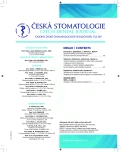Streptococcus Mutans and its Influence on Dental Status
(Original Article – Comparative Study)
Authors:
S. Halamová; M. Kadlecová; T. Dostálová
Authors‘ workplace:
Stomatologická klinika dětí a dospělých 2. LF UK a FN Motol, Praha
Published in:
Česká stomatologie / Praktické zubní lékařství, ročník 116, 2016, 2, s. 47-53
Category:
Original articles
Overview
Introduction:
Streptococcus mutans along with other factors plays an important role in the development of dental caries. In terms of optimalization of prevention of dental caries, there has been search for a reliable test for a chair side caries risk assessment. GC Saliva-Check Mutans allows us to semiqantitatively assess the amount of bacteria Streptococcus mutans in saliva.
Aim:
The aim of this study was to determine whether the patients with high concentration of Streptococcus mutans in saliva (i.e. positive result in Saliva-check mutans) are at higher caries risk than patients with lower concentration of Streptococcus mutans in saliva. Further, we compared three different methods of detection of carious lesions – clinical examination, x-ray and DIAGNOcam.
Material and methods:
Seventy patients aged 16–85 years were involved in the study. On each patient clinical examination was performed and also radiological (bitewing projection) and using intraoral camera (diagnocam), if indicated, in order to find initial caries lesions. To determine the concentration of Streptococcus mutans in saliva, commercially produced set GC Saliva-Check Mutans was used.
Results:
Our results have shown that patients who tested positive in Saliva-check mutans test have significantly more caries lesions (5.7) than patients who tested negative (2.7 caries lesions).
Conclusion:
Our study has proved that patients with higher concentration of Streptococcus mutans are at significantly higher caries risk. Saliva-check showed to be suitable for caries risk assessment. Then we proved, that we can detect more caries lesions by using intraoral camera than only by clinical examination or using x-ray.
Keywords:
dental caries – Streptococcus mutans – saliva – caries risk assessment – GC Saliva-Check Mutans
Sources
1. Beighton, D.: The complex oral microflora of high-risk individuals and groups and its role in the caries proces. Community Dent. Oral Epidemiol., roč. 33, 2005, č. 4, s. 248–255.
2. Borburema Neves, A. B., de Araujo Lobo, L. A., Caldas Pinto, K. C., Soares Pires, E. S., Requejo, M. E. P., Cople Maia, L. C., Goncalves, A. G.: Comparison between clinical aspects and salivary microbial profile of children with and without early childhood caries: a preliminary study. J. Clin. Pediatric Dent., roč. 39, 2015, č. 3, s. 209–214.
3. Custodio-Lumsden, C. L., Wolf, R. L., Contento, I. R., Basch, C. E., Zybert, P. A., Koch, P. A., Edelstein, B. L.: Validation of an early childhood caries risk assessment tool in a low-income Hispanic population. J. Public Health Dent., roč. 6, 2015, č. 10, s. 8–28.
4. Gao, X. L., Senevirnte, C. J., Lo, E. C. M., Chu, C. H., Samaranayake, L. P.: Novel and conventional assays in determining abundance of Streptococcus mutans in saliva. Int. J. Paediatr Dent., roč. 22, 2012, č. 5, s. 363–368.
5. Gregory, R. L., Filler, S. J.: Protective secretory immunoglobulin antibodies in humans following oral imunization with Streptococcus mutans. Infect. Immun., roč. 55, 1987, č. 10, s. 2409–2415.
6. Hahnel, S., Rosentritt, M., Burgers, R., Handel, G.: Surface pro-perties and in vitro Streptococcus mutans adhesion to dental resin polymers. J. Mater. Sci. Mater. Med., roč. 19, 2008, č. 7, s. 2619–2627.
7. Hänsel Petersson, G., Twetman, S., Bratthall, D.: Evaluation of a computer program for caries risk assessment in schoolchildren. Caries Res., roč. 36, 2002, č. 5, s. 327–340.
8. http://www.gcamerica.com/products/preventive/SALIVA-CHECK_MUTANS/SalivaCheckMutansIFU.pdf.
9. Matsumo, Y., Sugihara, N., Koseki, M., Maki, Y.: A rapid and quantitative detection system for Streptococcus mutans in salivary using monoclonal antibodies. Caries Res., roč. 40, 2006, č. 1, s. 15–19.
10. McDonald, R. E., Avery, D. R., Stookey, G. K.: Dentistry for child and adolescent. Contemp. Clin. Dent., roč. 2, 2011 č. 1, s 17–20.
11. Okahashi, N., Takahashi, I., Nakai, M., Senpuku, H., Nisizawa, T., Koga, T.: Identification of antigenic epitopes in an alanine-rich repeating region of a surface protein antigen of Streptococcus mutans. Infect. Immun., roč 61, 199, č. 4, s. 1301–1306.
12. Satou, J., Fukunaga, A., Morikawa, A., Matsumae, I., Satou, N., Shintani, H.: Streptococcal adherence to uncoated and saliva-coated restoratives. J. Oral Rehabil., roč. 18, 1991, č. 5, s. 421–429.
13. Satou, J., Fukunaga, A., Satou, N., Shintani, H., Okuda, K.: Streptococcal adherence on various restorative materials. J. Dent. Res., roč. 67, 1988, č. 3, s. 588–591.
14. Soni, H., Vasavada, M.: Distribution of S. mutans and S. sobrinus in caries active and caries free children by PCR approach. Int. J. Oral Craniofac. Sci., roč. 1, 2015, č. 1, s 27–30.
15. Straková, D., Dostálová, T., Ivanov, I. H.: Diagnostika kariézních lézí. Co umožňuje DIAGNOcam? Progresdent, 2014, roč. 20, č. 1, s. 22–27.
16. Tanzer, J. M., Livingston, J., Thompson, A. M.: The microbiology of primary dental caries in humans. J. Dent. Educ., roč. 65, 2001, č. 10, s. 1028–1037.
17. Wennerholm, K., Emilson, C.G.: Comparison of Saliva-Check Mutans and Saliva-Check IgA Mutans with the cariogram for caries risk assessment. Eur. J. Oral Sci., roč 121, 2013, č. 5, s. 389–393.
18. Zeng, L., Burne, R. A.: Sucrose- and fructose-specific effects on the transcriptome of Streptococcus mutans probed by RNA-Seq. Appl. Environ. Microbiol., roč. 82, 2015, č. 1, s. 146–156.
Labels
Maxillofacial surgery Orthodontics Dental medicineArticle was published in
Czech Dental Journal

2016 Issue 2
Most read in this issue
-
Importance of Centric Relation Registration by the Patients with Complete Dentures
(Practical Report) -
Dentigerous Cysts of Jaws
(Original Article - Retrospective Clinical Study) -
Maturogenesis Part 2. Irrigation Protocols, Intracanal Medication
(Review) -
Streptococcus Mutans and its Influence on Dental Status
(Original Article – Comparative Study)
